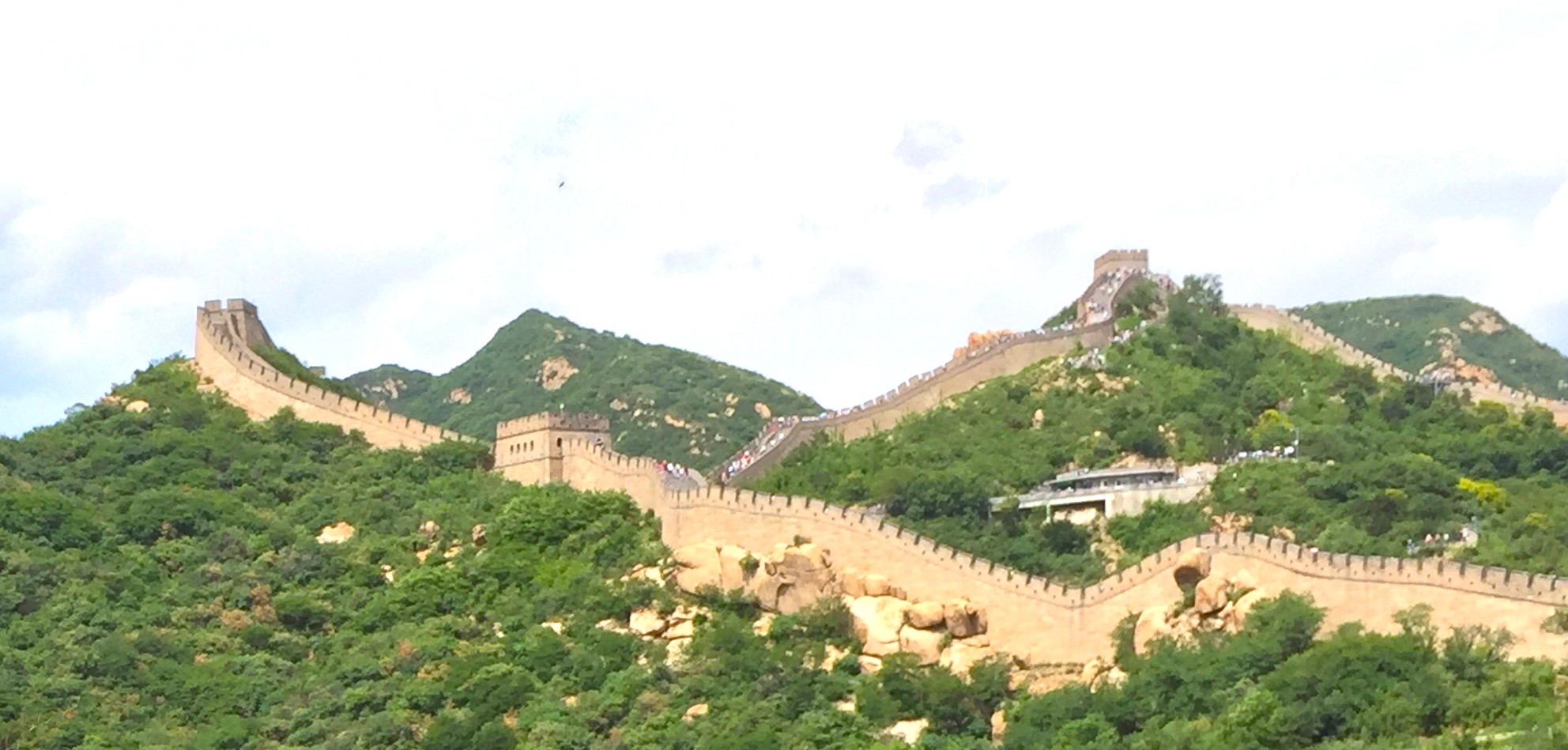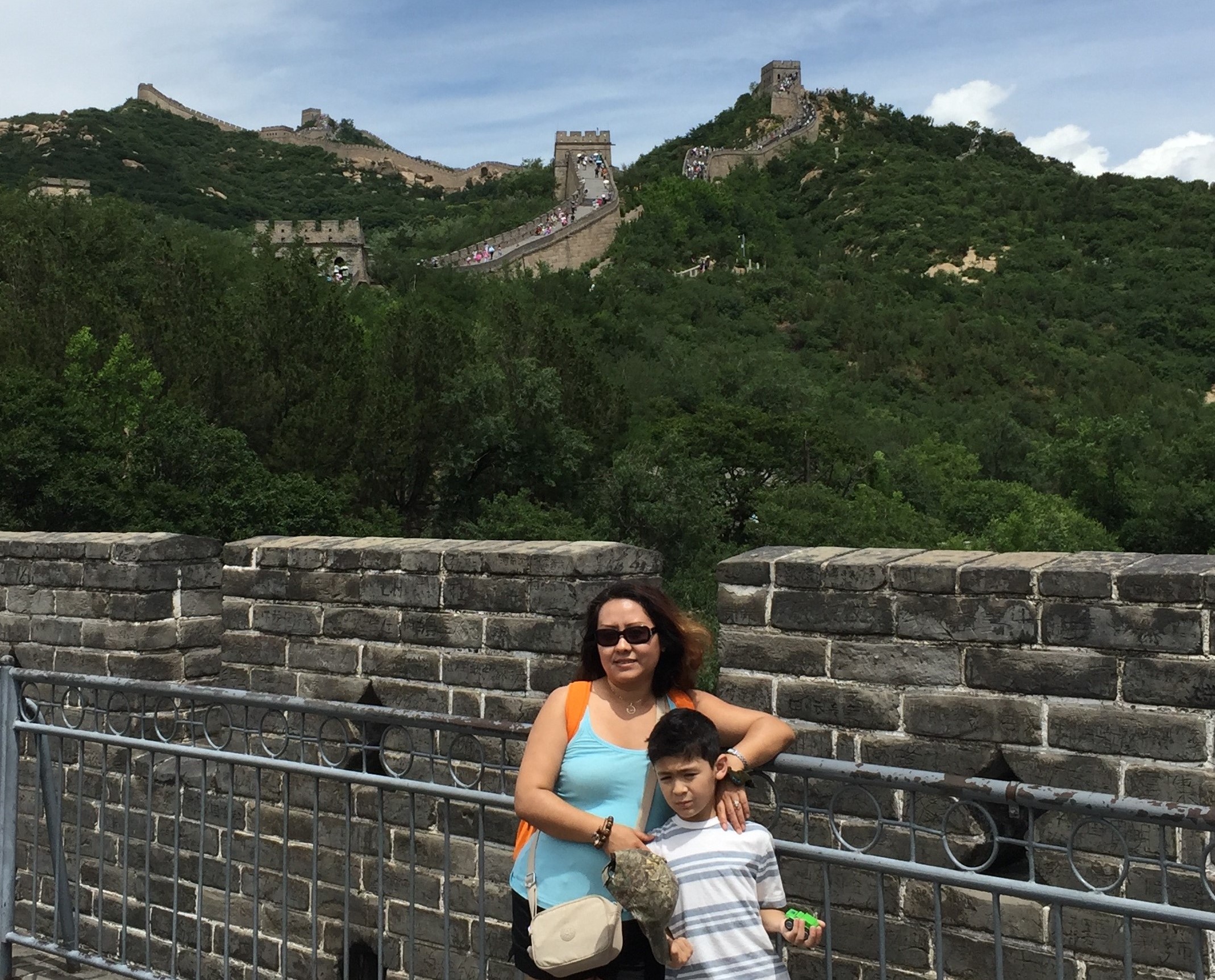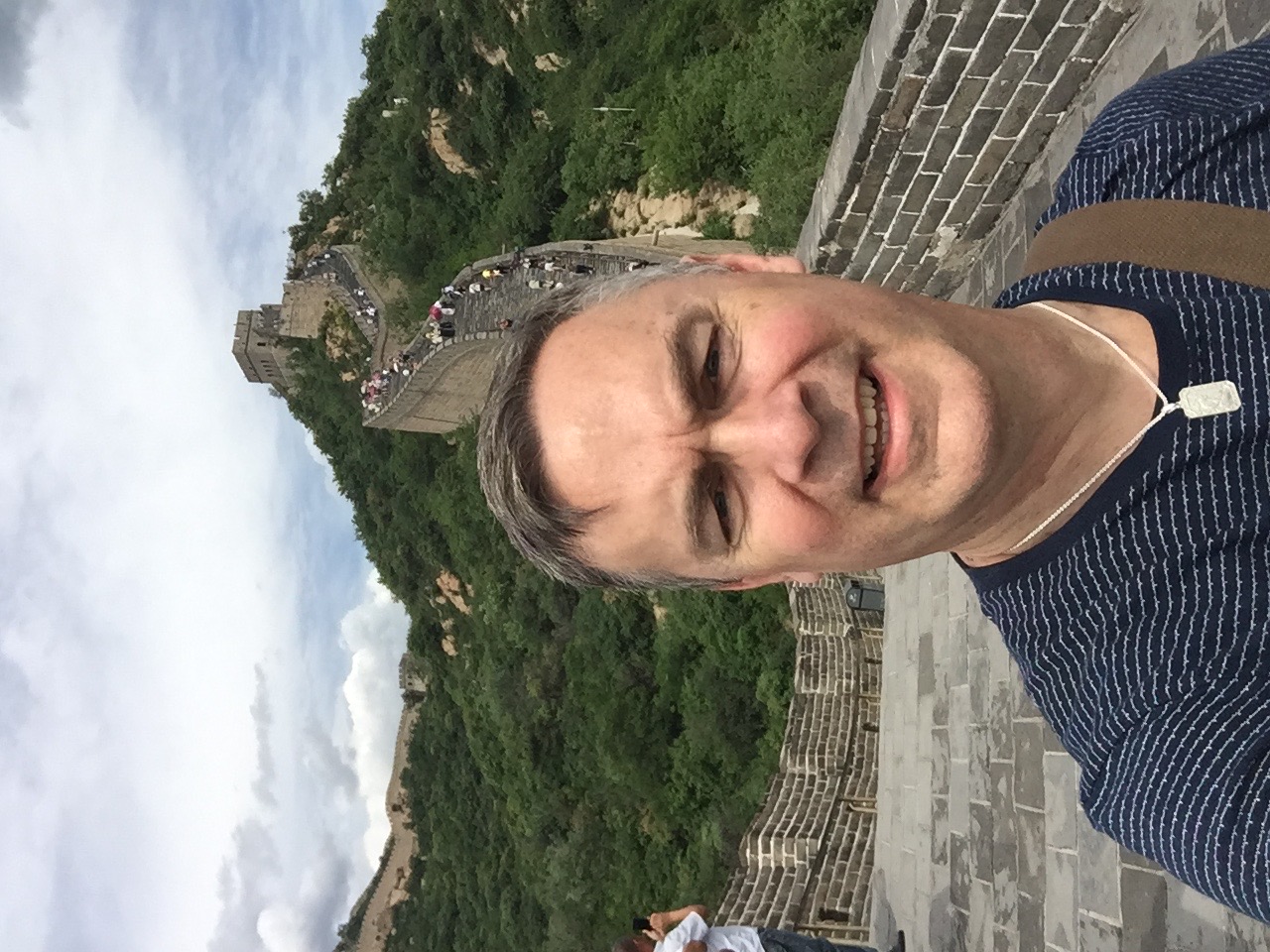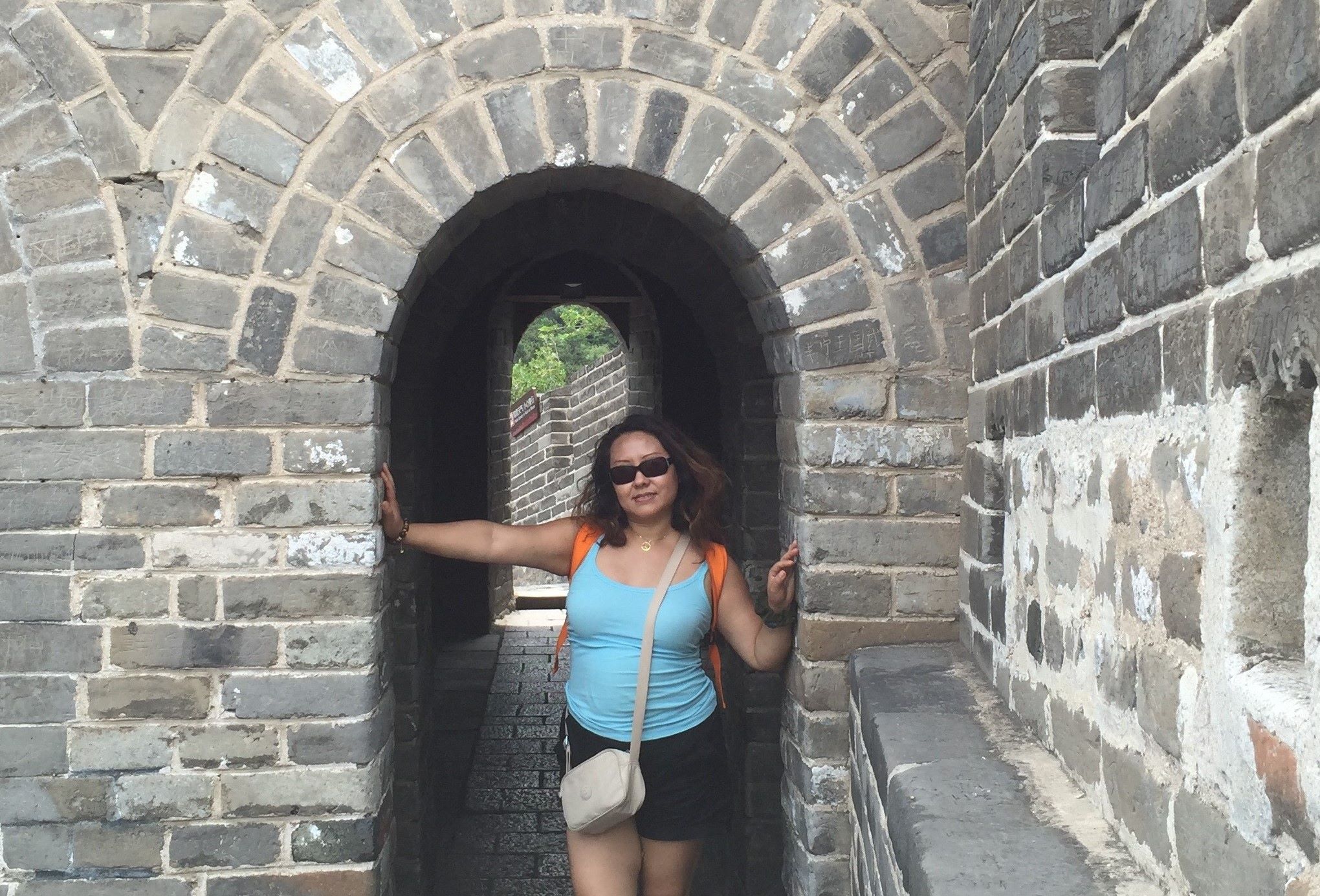June 14, 2006
Wednesday
Beijing
Ping has been talking about this part of the trip since the day we first discussed visiting China. We’re going to see one of The Seven Wonders of the World. But first, a good breakfast.
We load up at the hotel’s fine buffet. Omelets, bacon, and sausage add up to enough cholesterol to kill a horse. No matter. We need our strength. There’s also a bounty of fresh fruit, including something I’ve only seen rarely at the supermarkets back home: dragon fruit. I’ve never tried it. The ten-dollar per fruit price tag always drove me away. Here, I pile it high on the plate. It’s a wonderfully succulent citrus, not unlike kiwi but even more exotic somehow.
Driver Dong picks us up. He’s accompanied by his brother and another man, who is a tour driver in training. We’re off on the perihelion of our adventure. I have to stop that. I don’t want to fill my head with faux poetry. I’m not the first to visit this site, nor am I the finest lyricist to sing its praises. I struggle to keep it simple. Still… aw hell, I’m psyched! The Great Frickin’ Wall of China! This is so cool!
Ping brings me back to Earth, explaining that we have many places to visit today. In fact, we’re running behind schedule and she’s not sure that we’ll get to everything she had planned. I again wish she had been less ambitious in her planning, but I’m game for whatever we can fit in at this point.
We pull in to the Jade Market. It’s a tourist trap, but a nice one. There’s a brief tour past booths where skilled artisans take low-grade jade stone and carve it into the dragon or Buddha shapes that foreigners snap up by the dozens. One interesting trinket is a series of three or four concentric spheres. I watch the workers use first large power grinders, then progressively smaller and finer hand tools to smooth and carve the surfaces of each ball. Even though my eyes are seeing it, my brain can’t quite process how a solid chunk of green rock can become four – or in the pricier models seven or eight – globes. Each moves freely inside the larger ones. I’m tempted to grab one, but Ping stops me. Even the baseball sized ones are going for 420 bucks. Ping explains that this is one of the places where professional tour guides take their clients. The guides get a kickback, in the form of cash or jewelry. She promises to take me to a cheaper market later, where we can find the same things for ten bucks.
The jade workshop leads to the gift shop, which is the size of an aircraft hangar. We see every possible type of jade jewelry and more. We get some quick pictures next to a solid jade rendition of the Emperor’s yacht. It’s at least eight feet long. Someone’s added an anachronistic wallet sized photo of Mao to one of the cabin walls. He looks over my shoulder in one of the shots. Next, some lovely silk scrolls catch my eye. There are mountain scenes, and fierce tigers. Each is eighteen hundred bucks, well over two hundred dollars. It’s not that I mind paying that much for something truly nice, but Ping has a look on her face. So, I trust my guide and we pass on the scroll.
We pile back in the van. It’s very hot and we’re glad we’ve each brought several bottles of water still cold from the fridge in our hotel room. We pull up to a huge, pink building with a tiled pagoda roof. This is the Ding Ling Museum, which leads to the Ming Tombs at the base of the Jundu Mountains north of Beijing.
We get out. Driver Dong and the other two stay in the van while Ping and I go in. I feel bad to be leaving them, but they say they’ve seen this place so many times they aren’t interested. They’ll also skip The Great Wall. I’m not sure I comprehend that level of indifference. I guess this is what it must be like to live next door to Disney World.
The museum is literally a treasure trove. There are enormous vases and other artworks rendered in real jade. If these were in a fine export shop, I could mortgage my house and not come up with enough money to buy one. I’m particularly fascinated by the ancient gold jewelry and coins. The signs say these are a mix of real and replicas. In either case, they’re magnificent to the eye and conjure up wonderful imaginary people in the mind. All of these fine things are owned by the government. None are allowed into private hands. At least, that’s the official stance.
The museum is agreeably cool. Once we step out onto the stones of the sprawling Ming Tombs, it’s more like walking on a griddle. Each level is at least an acre. The levels are surrounded by low homes, possibly once housing for the soldiers who protected the Emperors’ rest. Things are laid out according to the rules of Feng Shui, in order to fend off evil spirits from the north. Each level leads to the next by a single, ornate flight of stone steps. These are divided into vertical rows by intricate stone carvings. They portray dragons, lions, horses, and heroes all in a heraldic motif. It finally dawns on me that I’m not walking through a graveyard. This is a necropolis, a city of the dead.
Ping knows some of this tour, but we defer to a guide for the bulk of this visit. She takes on a group of us, including a large number of tourists who go back and forth from English to their native German. The guide points to one twisted tree she says may be eight hundred years old. Others are barely three hundred.
Heading up a steep path, our guide points down to a quarried out section perhaps a hundred yards long and twenty feet deep. She says that’s one of the tombs. In fact, thirteen of the sixteen Ming dynasty emperors found their rest in this place. Twenty-three empresses joined them.
We come to a large building set atop a hill that seems to be the centerpiece of the Ming Tombs. This is the entryway to the underground palace of Emperor Wan-li, who died nearly four hundred years ago after a reign of 48 years. We pass through several enormous wooden doors fitted with brass studs. Ping quickly says there are eighty-one – nine rows of nine, very lucky. They’re also very heavy. Each door weighs several tons. We descend four flights of a winding stairway, and walk past repositories of thrones and other eternal keepsakes.
We’ve come to see the emperor, but he’s not home. Our guide reveals in dribs and drabs the rumored fate of Emperor Wan-li. She says that when Chinese archeologists unearthed this opulent mausoleum in 1957, they found room after room. In the final great hall, they found the coffins of the emperor and two of his empresses. Almost immediately, though, the rush of fresh air after so many centuries began to have an effect. The imperial remains began to decay. Not knowing what to do with them, or perhaps not valuing them, the archeologists discarded the moldering bits of bone and wood from the original coffin. In short, Wan-li and the ladies went out with the trash. The diggers kept the valuable jewelry and other artifacts.
Ping fires off a few quick shots of me next to the enormous bright red wooden crypts that stand in for the original coffins. I’m amassing quite a collection of pictures of me standing next to dead emperors. Then, someone whispers tersely that we’re not supposed to use cameras down here.
I’m pleased to climb back to the world of the living. It’s difficult, if not impossible, to relate to the mindset of the millions of people involved in building and maintaining this city over the centuries. I see it as a work of art on a grand scale, a decorative history lesson. The emperors and their subjects, as well as modern Chinese must see this as a normal part of life. The powerful live at a level the peasants can only dream about. Until fairly recent times, no non-workers would have been allowed to visit the Ming Tombs. I’m glad that’s changed.
There are more places to buy souvenirs here. Mostly, it’s plastic junk and toys for the kids. Surprisingly, we find more of the scrolls we saw earlier. They are also made of silk, though I begin to see that’s not that big a deal. We choose two that will fit in our suitcases. They’re the same size as before, but instead of costing eighteen hundred bucks, we get them for thirty-six and forty-five bucks.
We rejoin Driver Dong and the others and hit another tourist trap for lunch. I’m grateful to find ice for my coke and clean toilets. I’m surprised to hear American accents. This is one of the few times we’ve come across Americans. I know they’re American, because they eat with forks and I hear them ask the waitress for ketchup.
The meal is clichéd American Chinese food: General Tsu’s chicken, hot and sour soup, and rice. I really have no idea who General Tsu was. Maybe he outranked Colonel Sanders. They seem to share a love of making Americans fat. The meal is what tourists expect. I can’t prove it, but it tastes like it was made up from frozen packages, perhaps take-out from America. We choke it down and rejoin the others out in the parking lot. I’m very grateful the whole trip is not what I ‘expected.’
It’s a long stretch of winding road on this leg. We’re in steep foothills, which bring to mind the settings in the silk scrolls we’ve just bought. We pass a few country homes, in the style we saw in Hebei Province. There’s far more shade here, and even cooling waterfalls and rivers. I always thought Chinese paintings exaggerated the relationship of man and nature, showing human figures tiny against soaring mountains. Now I see they don’t tell the half of it. These hills offer many wide vistas, exposing just how minute the human creations are.
Civilization gradually becomes more pronounced. We pass larger and larger villages, built up the sides of jagged-topped mountains. Donkeys haul cartloads of fruit and vegetables from lush orchards. They share the clean, paved roads with late model western cars. In fact, the area looks to have benefited from its famous landmark. Ping says people come from Beijing to enjoy their weekends relaxing in a country home.
Driver Dong turns over the wheel to his brother, while he chats with us. He says a traveler once struck a goat while driving these village roads. A farmer ran out and demanded he pay 500 bucks in reparations. The story apparently spread. Businessmen frequent the area, looking for prostitutes. They then list the adventure in their expense accounts: hit a goat, 500 bucks.
I’m laughing at this when the breath catches in my throat. There’s a tower on the far hilltop. It’s huge. And it’s not alone. The bastion is connected to others in either direction. Trees and a hill obscure the view, then it returns even nearer and larger. It’s like something out of an ancient legend come to life. I’ve pictured structures like this in my head while reading J.R.R. Tolkein and Sir Walter Scott. But, those were imaginary bulwarks. I’m actually looking at The Wall. Or rather, I’m seeing a tiny piece of this nearly four thousand mile-long, millennia-old defensive masterpiece.
People visit the site at any one of hundreds of entry points. Ping says parts of The Great Wall are in ruins, while others are freshly renovated. Many segments of the Great Wall adjacent to Beijing were reconstructed during the Ming dynasty. For centuries impoverished peasants living in the surrounding areas kept tearing down the Wall and carting away bricks and rocks for use in building homes. We choose a newer section, coming in at Mu Tian Yu.
We maneuver up as close as possible to find a parking place. The wall is built like the spikes of an impossibly large dinosaur on a mountain range. There is little or no horizontal ground. Driver Dong and the others again remain with the van, while Ping and I venture into the welcoming area.
One look and we know: the invaders have won. Not the Mongol hordes of old, but the tourists. Villagers and merchants have turned the base of this section of The Wall into a non-stop country fair. There are hundreds of tiny booths and tents here, all brimming with every imaginable piece of kitsch and crap.
Looking past this ersatz bazaar, I’m glad to see that The Wall itself it mostly devoid of people. We begin a climb up roughly hewn stone stairs. The Wall is still a good distance above us, and I can feel my knees protesting already. Ping takes us to a shortcut. Oh. My. God. It’s a ski lift. It’s steeper than any I’ve ever seen and it looks like a strong breeze could snap the cable. We climb right on.
The seat below us creaks as it rocks back and forth. The ascent offers an amazing view, although I can’t help but wonder how safe this thing is. Ping says she usually takes a much nicer enclosed cable car. This thing has got to be thirty years old. I can’t imagine any insurance company signing off on it. There aren’t even seat belts, just a bar on which to lean my hands while praying.
My foot literally brushes the tops of trees as we find ourselves sixty feet above the ground. And we’re going higher. No engineer worth a damn would design anything this steep and flimsy. I have to believe this was a cheap purchase brought over from somewhere else. The chair moves slowly, and I pull out my journal to jot down my thoughts. Ping is slapping my shoulder because my every move makes the chair sway harder. I look down again and we are – no shit! – one hundred feet about the rocky mountain slope, dangling like damned fools.
So naturally, the chair stops.
Ping and I look at each other, wondering what’s going on. There’s no one else on the lift that we can see in either direction. I can’t see the top. I can’t see the bottom. I figure someone down there will restart the winch in a second or two. But, this goes on. It’s long enough to settle my urine. Ping is getting panicky, and I don’t blame her. I have a dandy case of vertigo. I thought it wouldn’t kick in while I was seated, but I’m wrong. I do the only thing I can think of to take my mind off our impending deaths. I kiss my wife. It helps.
In real time, the motor starts again and we’re moving after about three minutes. It feels much, much longer. We pass an older couple. The man says, in English, “Have fun!” His wife adds, “You have a good climb ahead of you.”
Moments later, a heavily accented voice yells, “Feet up!” The sky chair dumps us onto the platform. We’re here. We’re standing on The Great Wall of China.
A pair of teenagers is manning the top of the ski lift. Once we get away from that area, we’re pretty much alone. There are a few signs, and then only the mountains, the clouds, the wall and us. . I desperately want to think of something profound. All that comes to mind is: “It’s big.”
There are innumerable and uneven stone steps. Ping reminds me this is the new section. That is, it’s been renovated for the tourists. I check the largest stones. Their edges are clean and sharp. These are not twenty-five hundred years old. They’re blocks made out of river mud, most barely half as old as I am. Hmm, I’m older than The Great Wall of China. How’s that for profound? Ping says the older parts of The Wall are even steeper than this section. She considers those parts to be too dangerous to visit.
It suddenly occurs to me that this wall didn’t just jump up here on its own. There were a couple of original incarnations going back to the fifth century BC. Ping says each dynasty has taken on the task of refurbishing The Wall. There were no cranes, no complex machines in the past or even in relatively recent ventures. This was accomplished with break breaking labor on a scale I cannot even imagine. Men died doing this, in numbers no one bothered to record. Ping says some guesstimates put the number of lives lost building this wall at over one million. I have to take a moment to catch my breath, and let that thought sink in.
Weather sweeps overhead, releasing a brief shower. The air and rain are both warm, so there’s no distress. The image of small dark clouds dragging their shadows over the farms far below is worth getting wet. Ping and I make our way to one of the bastions to rest our legs and get in some much needed misbehavior. I seriously consider going for more than a kiss. There really aren’t that many people up here. Still, this moment is wonderful as it is.
The bastion is the size of a house. I wonder whether the authorities allow people to bring bedrolls for overnight stays. I’d love to try that. There is no furniture, just a series of rooms without doors, and an upper level. There’s no plumbing, which exposes a flaw in our strategic planning for this visit. For once, I’m not the one suffering. I point out to my bride that the rainwater is finding release through some drains carved through the stones of the parapets. She goes with the flow. Take that, Mongol hordes! Ping makes me promise not to write this down in my journal.
The bastions, or turrets, are spaced to fit the mountain range. The jagged peaks force visitors to climb up and down many flights of stairs at a time. One of the largest we attempt to cross today must equal six flights of stairs in a regular building. The steps themselves are taller than is strictly comfortable. All in all, this is quite a workout.
After reaching five or six bastions, we decide we’ve made a good show of it. We’ve been climbing stone steps for about an hour. We head back. I seriously could stay up here for days. But, the thought of even attempting to cover any great length of The Wall gets filed away in my head alongside climbing Everest.
The trip back down to the village is far less frightening than the trip up. Below, I can see a long, winding toboggan track. It must be more than a mile in length. The teenagers who man the upper station rent wheeled sleds. Ping says no. There are no guardrails, and no brakes. It’s another chance at suicide, and we’ll pass.
We reward our sage cowardice by purchasing some ‘I climbed The Great Wall’ t-shirts. I wouldn’t buy these anywhere else.
As we drive back to the hotel, I try to put into words what I’m feeling. I can’t compare this to anything else. It’s one of a kind. I feel alive. I feel love for my wife at my side, and for my babies half a world away. I feel something I’ve worked a great deal of my life to feel. In this moment, I feel grateful.
More action in China: https://www.amazon.com/Zebulon-Angell-Shadow-Chris-Riker/dp/1637107056/



